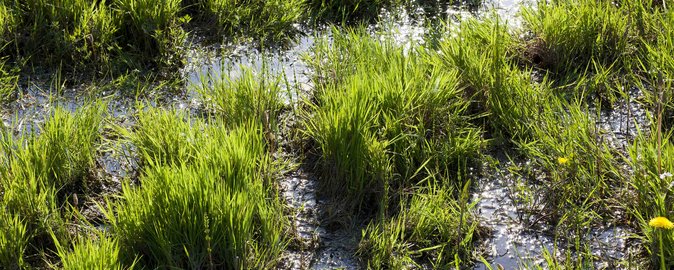



Plants can reduce nitrous oxide emissions from flooded grasslands
Nitrous oxide emissions increase significantly when grasslands are flooded repeatedly, according to new research from the Soil Biology Group, Wageningen University, and the Department of Agroecology at Aarhus University. The researchers found that certain plant species can help mitigate nitrous oxide emissions in flooded grasslands.
Climate change is causing more extreme weather, which affects Earth’s natural ecosystems in various ways. One of the consequences of climate change is increased rainfall intensity and thus, an increased risk of flooding. According to the researchers, flooding can adversely affect agricultural grasslands by increasing plant mortality and reducing grassland yield. Flooding can also increase nitrogen losses via increased nitrous oxide emissions.
Researchers from the Soil Biology Group, Wageningen University, the Department of Agroecology at Aarhus University, the Netherlands Institute of Ecology, and the Vrije University Amsterdam, have investigated how flooding affects nitrous oxide and methane emissions from grasslands. They tested whether different plant communities could mitigate flood-induced increases in emissions.
“Previous research shows that flooding can cause fluctuations in nitrous oxide emissions with high emissions at the start and end of the flooding period. In this study, we determined what happens before, during, and after repeated floods, because we expected that an increased frequency of flooding would increase nitrous oxide emissions. Flooding may also turn grasslands into a source of methane emissions, as seen in rice paddies and some peatlands. Therefore, we determined if certain plant communities (in monoculture or mixed communities) could reduce greenhouse gas emissions from flooded grasslands,” says tenure-track researcher Diego Abalos from the Department of Agroecology at Aarhus University.
Surprising results
The researchers investigated how repeated flooding affects the nitrous oxide and methane emissions by examining 11 different compositions of plants in arable soil from an 18-month-old field experiment at Wageningen in the Netherlands. Four plant species were studied in monoculture (each plant species separately), in mixtures of two plant species, and in a mixture of all four plant species. The four plant species included in the experiment were:
- Tall fescue (Festuca arundinacea)
- Perennial ryegrass (Lolium perenne)
- Rough meadow grass (Poa trivialis)
- White clover (Trifolium repens)
“When we started our experiment, we expected that the ability of certain plant species to quickly take up nitrogen could help to lower nitrous oxide emissions under non-flooded conditions. Our hypothesis was that flooding would increase nitrous oxide and especially methane emissions due to the plant’s reduced ability to take up nitrogen, and the decay of dead plant material in the soil,” says Natalie Oram, lead author of the study, Soil Biology Group at Wageningen University.
To test this hypothesis, the researchers measured greenhouse gas emissions from the 11 plant communities in non-flooded conditions (control), and the same communities exposed to repeated flooding. The results surprised the researchers.
“We found that flooding increased the global warming potential more than expected. This was mainly due to a large increase in nitrous oxide and not methane emissions, as we had otherwise expected. It surprised us that nitrous oxide emissions increased as much as they did. On average, nitrous oxide emissions were 97 times higher in flooded than non-flooded conditions, while methane emissions were only 1.6 times higher,” says researcher Gerlinde De Deyn, Soil Biology Group at Wageningen University.
The plants can help
The researchers found that certain plant communities can mitigate flood-induced nitrous oxide emissions. For example, increasing the abundance of tall fescue was related to lower nitrous oxide emissions. Nitrous oxide emissions from the tall fescue monocultures were 54% lower than other monocultures.
“This shows us that when faced with extreme weather events, tall fescue will be an important plant species to include in the mixture of plants to grow in the grasslands. It can cope with large temperature differences, as well as both flooding and drought, while it at the same time reduce the emission of nitrous oxide,” says Diego Abalos.
A mix of plant species is the way forward
The researchers found that certain plant species can increase or decrease nitrous oxide emissions. For example, legumes that fix nitrogen from the air increase the amount of nitrogen in the soil via their nitrogen-rich decomposing roots. If this nitrogen is not taken up by surrounding plants, it can be emitted as nitrous oxide. On the other hand, tall fescue can decrease nitrous oxide emissions, and this could be due to its less decomposable, nitrogen-poor roots.
"We now know that nitrous oxide emissions in flooded grasslands is high, and that different plant species can affect these emissions in different ways. We have also seen that flooding in managed grasslands does not emit large amounts of methane, as for example rice paddies do,” says researcher Jan Willem van Groenigen from Soil Biology Group Wageningen University.
The study also shows that under flooded conditions, plant combinations with a high root carbon to nitrogen ratio (nitrogen-poor roots) were associated with lower nitrous oxide emissions.
"Plant functional features related to slower degradation and nitrogen mineralisation can play a significant role in reducing nitrous oxide emissions in flooded grasslands, which is why the mix of plant communities in grasslands are extremely important in a future with more extreme weather," concludes Diego Abalos.


